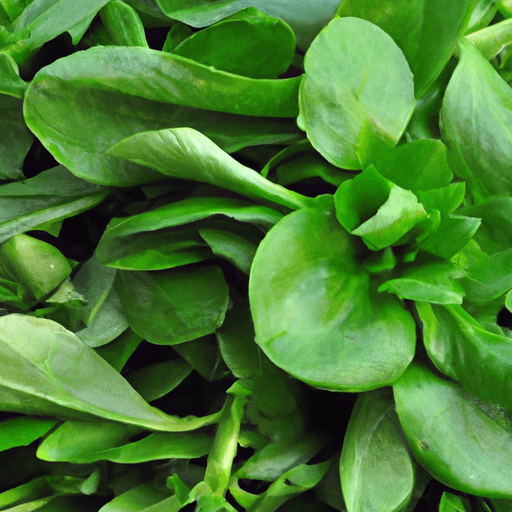Mâche: The Nutrient-Rich Green with a Delicate Flavor
If you’re a fan of tender and velvety salad greens, then mâche is definitely worth adding to your kitchen repertoire. Also known as lamb’s lettuce or corn salad, mâche is a leafy green that is as visually appealing as it is nutritious. With its delicate taste and versatility in cooking, mâche has gained popularity among food enthusiasts and health-conscious individuals alike.
Taste and Texture Mâche leaves have a mild and slightly nutty flavor, reminiscent of butter lettuce. This delicate taste pairs well with a range of ingredients, making it a versatile option for all kinds of recipes. It has a tender and velvety texture, adding a pleasant mouthfeel to any dish it’s incorporated into.
Common Uses in Cooking Mâche is an incredibly versatile green that can be used in a variety of dishes. Its delicate flavor profile makes it a great addition to fresh salads, providing a unique texture and taste. You can use mâche as a stand-alone ingredient or mix it with other salad greens for added complexity.
Apart from salads, mâche can also be used in cooked dishes. It wilts quickly when cooked, so it’s best to add it towards the end of the cooking process to preserve its vibrant color and tender texture. It pairs well with seafood, poultry, and mushrooms, allowing you to create delicious and visually appealing dishes. Consider adding a handful of mâche to stir-fries, soups, pasta dishes, or even as a garnish for various entrees.
Nutritional Value Aside from its culinary versatility, mâche is packed with essential nutrients, making it a valuable addition to a healthy diet. It is an excellent source of vitamins C and K, providing a significant boost to your immune system and promoting healthy bones. Additionally, mâche is rich in beta-carotene, a powerful antioxidant that supports eye health.
Furthermore, mâche contains minerals like potassium and calcium, essential for maintaining proper hydration and promoting strong bones and teeth. It is also a good source of dietary fiber, aiding in digestion and maintaining a healthy gut.
Interesting History and Facts Mâche has a long history and is widely consumed in European cuisine. It is believed to have originated in the Mediterranean region and was cultivated by ancient Egyptians and Greeks. Over time, it gained popularity across Europe, particularly in France, where it is commonly referred to as “doucette” and is featured in many traditional dishes.
An interesting fact about mâche is that it grows exceptionally well in colder climates and is often harvested during the winter months, making it a common ingredient in winter salads. Its cold-hardy nature and ability to thrive in low light conditions contribute to its availability even in the harshest seasons.
In Conclusion If you’re looking to elevate your salads or add a touch of elegance to your cooked dishes, mâche is a green that deserves your attention. With its delicate flavor, tender texture, and impressive nutritional profile, mâche offers a delightful culinary experience. Incorporate mâche into your repertoire, and you’ll be treating yourself to a versatile and nutrient-rich green that adds both flavor and visual appeal to your meals.
Mâche
Origin: Mâche (Valerianella locusta), also known as lamb’s lettuce or corn salad, is a leafy green that is native to Europe and commonly found growing wild in the Mediterranean region. It has been cultivated for centuries and is now popular in various parts of the world.
Common Uses: Mâche is often used in salads, either alone or mixed with other greens. Its tender leaves have a mild, nutty flavor and a delicate texture. It pairs well with vinaigrettes, citrus-based dressings, and savory ingredients like roasted vegetables or grilled chicken.
Nutritional Benefits: Mâche is a nutritious green vegetable with several health benefits. It is a good source of vitamins A, C, and K, as well as folate and potassium. It also contains beneficial antioxidants, such as beta-carotene and lutein.
Unique Properties: One unique property of mâche is its high omega-3 fatty acid content. Compared to other leafy greens, mâche has a higher concentration of these essential fatty acids, which are known for their heart-healthy effects. Additionally, unlike many other greens, mâche can tolerate colder temperatures and is often harvested during the winter months.
Historical Significance: Mâche has a long history of cultivation. It was used as a winter salad green by the ancient Romans and has remained popular in European cuisine ever since. In France, mâche is particularly beloved and is often featured in traditional recipes and regional dishes.
Overall, mâche is a versatile leafy green with a mild, nutty flavor. It is notable for its nutritional benefits, including its omega-3 fatty acid content, and has a rich historical significance in European culinary traditions.




Use the share button below if you liked it.
It makes me smile, when I see it.